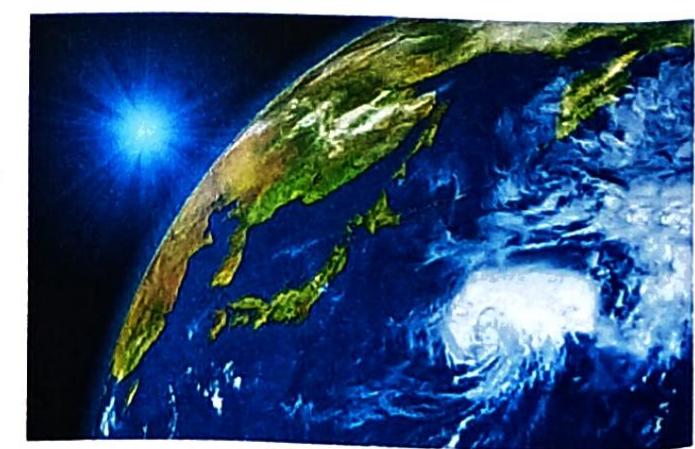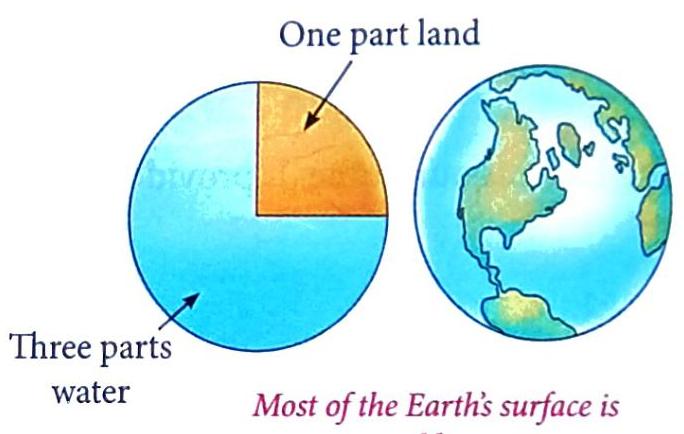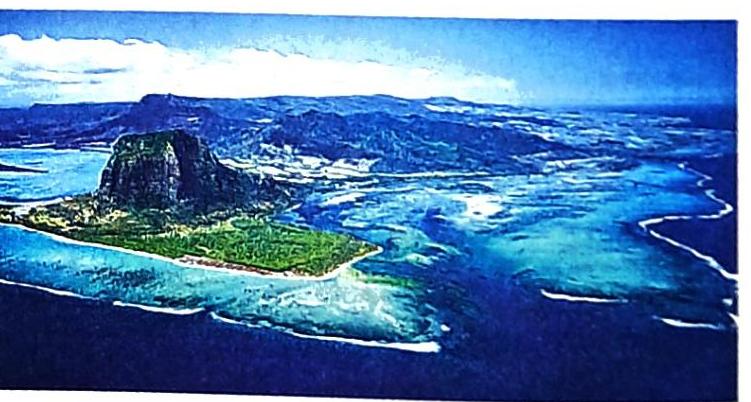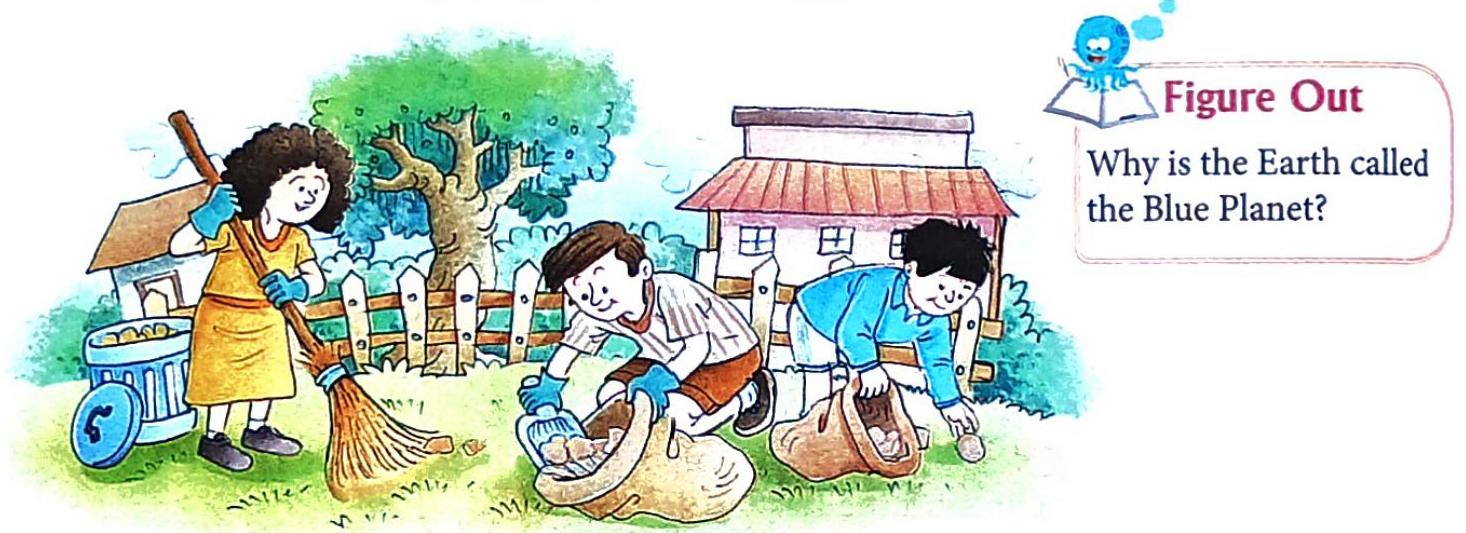Chapter: 16. The Earth
16 The Earth: Our Amazing Home
Welcome to your self-study guide on our wonderful planet, Earth! In this guide, you will explore what makes our Earth special and how we can all help to take care of it. Get ready to learn some fascinating facts!
Let’s Learn About…
Here’s what you’ll discover in this chapter:
The Earth as a living planet: What makes Earth the only known place in our solar system where life thrives? The shape of the Earth: How do we know what shape our planet is, and what does it really look like? Taking care of Mother Earth: What can we do to protect our home and keep it healthy for everyone? Key Terms
Before we begin, let’s understand some important words you’ll come across:
Earth: Our home planet, the third planet from the Sun. Sphere: A perfectly round, three-dimensional shape, like a ball. Unique: Being the only one of its kind; special. Atmosphere: The layer of air that surrounds the Earth. The Earth
For a long time, people had different ideas about the shape of the Earth.
Old Beliefs: In ancient times, many believed the Earth was flat. Imagine how scary that might have been, thinking you could fall off the edge! A New Idea: However, some people believed the Earth was round, like a giant ball. Proving the Truth: The first person to actually prove that the Earth is round was Ferdinand Magellan. He was a brave explorer who set sail one day, heading west. After an incredible journey that lasted three years, he and his crew returned to the exact same place they had started from. This amazing journey showed everyone that the Earth is indeed round!
The Earth from space
Shape of the Earth
While we say the Earth is “round,” its shape isn’t a perfect sphere like a marble.
Spherical Shape: Our Earth is spherical in shape, but it’s not perfectly round. Flattened Poles: It’s actually slightly flattened at the top and the bottom, much like an orange. The flattened end at the top is called the North Pole. The flattened end at the bottom is called the South Pole. Why it Appears Flat: When we look around, the Earth appears flat to us because we can only see a small part of its huge surface at any given time.
Unique Earth
The Earth is often called unique because it stands out from all other planets in our solar system. It’s the only planet where we know life exists!
Surface Composition: The Earth’s surface is made up of two main parts: Land: One-fourth (1/4) of the Earth’s surface is land. Water: Three-fourths (3/4) of the Earth’s surface is covered by water. Life-Sustaining Conditions: Earth has special ingredients that allow life to thrive: Air
All living things on Earth, from the smallest insect to the largest whale, need air to breathe.
Atmosphere: The layer of air that completely surrounds our Earth is called the atmosphere. It acts like a thick, protective blanket around our planet. Gases in the Atmosphere: The atmosphere is made up of important gases: Oxygen: This is a vital gas that both plants and animals need to survive and breathe. Carbon dioxide: Plants use this gas to make their own food. Nitrogen: This is the most abundant gas in the atmosphere. Protection from the Sun: The atmosphere also plays a crucial role in protecting us. It stops many of the Sun’s harmful rays from reaching the Earth’s surface. Figure out
Mountaineers carry oxygen when they go up mountains because:
Answer: As mountaineers climb higher up mountains, the air becomes thinner, meaning there is less oxygen available to breathe.
Water
Just like air, water is absolutely essential for all living things to survive.
Only Planet with Water: Earth is the only planet in our solar system that has liquid water on its surface. Without water, there would be no plants or trees on land. If there were no plants, there would be no oxygen for humans and animals to breathe. Without water, the entire planet would be lifeless.
The Earth has water
Temperature
The Earth’s temperature is just right for life to exist, thanks to its perfect distance from the Sun.
Perfect Distance from Sun: Earth is neither too close to the Sun (which would make it too hot) nor too far away (which would make it too cold). It receives just the right amount of heat. During the day: Clouds help by blocking some of the Sun’s powerful rays, preventing the Earth from getting too hot. At night: Clouds act like a blanket, trapping the Earth’s heat and preventing it from escaping into space, which keeps the night from getting too cold. FactPedia: Did you know that Earth Day is celebrated on 22 April every year? It’s a special day to remember how important our planet is!
Taking Care of the Earth
The Earth is our precious home. It provides us with everything we need to live, from the air we breathe to the food we eat and the water we drink. It’s our responsibility to protect it!
Here are important ways we can protect our Mother Earth:
Do not litter: Always put your trash in a bin. Never throw it on the ground or in water bodies. Water: Turn off the tap when brushing your teeth, take shorter showers. Food: Only take what you can eat, store food properly to prevent spoilage. Electricity: Turn off lights and fans when you leave a room, unplug electronics when not in use. Do not pollute: Avoid actions that pollute the land, air, or water. This includes using fewer chemicals, walking or cycling instead of driving when possible, and properly disposing of waste. Plant trees: Trees are vital for our planet! They give us oxygen, absorb carbon dioxide, and provide homes for animals. Instead of cutting them down, we should plant more. Green Earth: Remember, all living things on Earth depend on humans to take care of it. This means we have a big responsibility to protect our Earth for everyone, including future generations.
In a Nutshell
Here’s a quick recap of the most important things you’ve learned about our amazing Earth:
Unique Features: The Earth has special features like air, water, and the perfect temperature that make it possible for life to exist here. Air for Life: All living things need air to breathe and survive. The atmosphere provides this essential air. Water on Earth: A huge part of the Earth’s surface – three-fourths (75%) – is covered by water, while the remaining part is land.
 Self Study
Self Study
The Earth from space
The Earth from space







The Earth has water
The Earth has water




